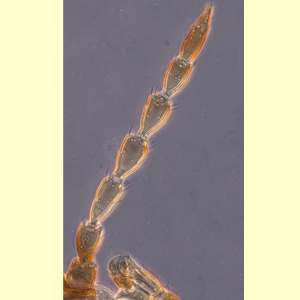Figures
Fig. 1: Antenna
Fig. 2: Head dorsal with ocellar triangle and maxillary bridge
Fig. 3: Pronotum
Fig. 4: Prosternal sclerite plates
Fig. 5: Meso- and metanotum, I. abdominal tergite, pelta
Fig. 6: Tergites IV - VI
Fig. 7: Sternites V and VI
Fig. 8: Tergites VIII-X
ITS-RFLP gel patterns (1&8 ladder, 2 PCR-product, 3 RSAI, 4 HaeIII, 5 MspI, 6 HinfI, 7 AluI)
Fig. 9: Primer pair CS249/CS250
Fig. 10: Primer pair O1/18J
Fig. 11: Primer pair 18SMP/28SMP
Taxonomic Information
Species:
Klambothrips myopori Mound & Morris, 2007
Synonyms:
Rhynchothrips Hood, 1912
Hoodia Karny, 1910
Smerinthothrips Schmutz, 1909
Phyllothrips Hood, 1908
Common name:
None established
Present taxonomic position:
Family: Phlaeothripidae Uzel, 1895
Subfamily: Phlaeothripinae (Uzel) Priesner, 1928
Genus: Klambothrips Mound & Morris, 2007
Species Recognition
General information about the genus Klambothrips:This is a newly described genus with only four species currently known. It is believed to originate from Australia or New Zealand and was introduced into Southern California where it was identified as a serious gall forming pest on Myoporum species. The genus is characterized as a stout black or brown thrips with large thick forearms, stout cheek setae, and similar in form to the genus Teuchothrips.
Typical character states of Klambothrips myopori:
Body color
Mainly brown
Antennae
Number of antennal segments: 8
Segment III - number of sense cones: 1
Segment IV - number of sense cones: 3
Segments III & IV sensoria: emergent and simple
Head:
Basal thirds of cheeks: with a pair of stout setae
Maxillary stylet position: about one third of head width apart
Postocular setae: shorter than distance of the setal base from the eye
Postocular setal apex: capitate to broadly expanded
Maxillary bridge: present
Cheeks: with one pair of stout setae in basal third
Prothorax
Pronotum: with faint sculture
Prosternal basantra: absent
Metathorax
Metanotum structure: with irregular equiangular at anterior, but longitudinal reticulations on posterior half
Wings
Wings: present and more than half as long as abdomen
Forewing shape: parallel sided
Forewings: surface smooth, without veins, setae and microtrichia
Legs
Fore femur: without a strong, cylindrical tooth near the base
Abdomen:
Abdominal segment X: complete tube in both sexes
Abdominal tergites: with curved wing-retaining setae
Biology
Life history:
This species feeds on the foliage of Myoporum species which causes distortion and with heavy infestations, ultimately leaf defoliation. The adult females induce leaf galls where they lay their eggs and the larvae develop. Development time from egg to adult has yet to be studied. With greenhouse temperatures the developmental time from egg to adult can decrease to about one week.
Host plants:
Myoporum spp. (Myoporaceae)
Vector capacity:
None identified
Current known distribution:
Africa,Asia, Australia, New Zealand,
Central and South America, Europe, North America
Additional notes:
This species has been collected on Myoporum along
the coast of California from Santa Diego County north to Santa Barbara
County.
Bibliography
Arakelian, G (2007): New
agricultural pest of southern California Myoporum thrips (Klambothrips
). County of Los Angeles Agricultural Commissioner/Weights and Measures
Department.
Mound, LA & Morris, DC (2007): A new thrips
pest of Myoporum cultivars
in California, in a new genus of leaf-galling Australian Phlaeothripidae (Thysanoptera),
Zootaxa 1495: 35–45.
Links:
Mound, LA (2005): Thysanoptera (Thrips) of the World
- A Checklist. http://www.ento.csiro.au/thysanoptera/worldthrips.html












